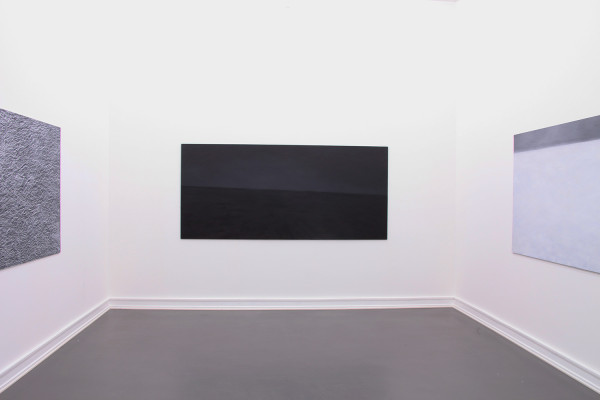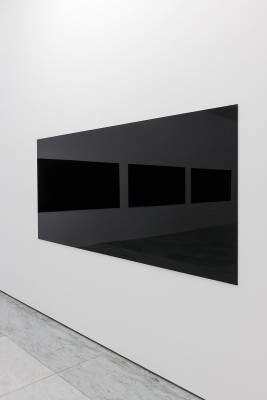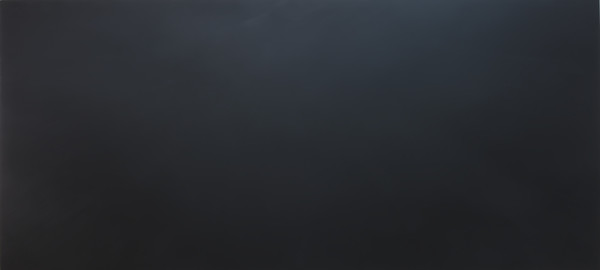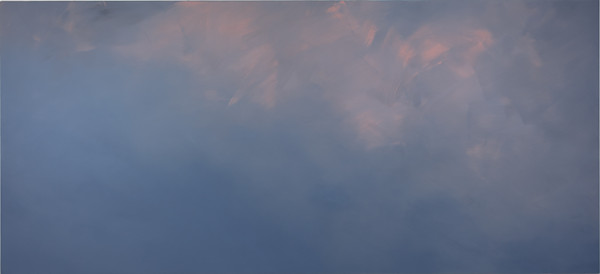Looking South – Looking for Painting
Trondheim Kunstmuseum Bispegata
Solo exhibition at Trondheim Art Museum, 16.februar 2013 – 24.mars 2013. Catalog text follows below.
Sometimes when turning on a radio, you just get a lot of noise, audio-garbage that appear as radio waves. Its equivalent is called visual noise when it is appearing in digital images. It is a lack of apparent meaning, or meaning that is just arbitrary. But audial noise is still sound, and visual noise is ultimately also an image.
Patrik Entian uses this form of visual noise to create images where we are forced to reflect both on the nature of painting – as pigments applied to a surface – and the nature of meaning. He uses noise from research cameras placed in fixed positions somewhere in the world, most likely places where the climate is extreme and no humans can endure to stay. These images might be products of digital disturbances, or the intervention of a blizzard, plain darkness or passing light phenomena. We cannot tell. In fact, we cannot tell what is “real”, and what is “abstract”. His work involves reflections on landscape painting, on science and the nature of seeing.
Patrik Entian (born 1966 in Karlstad, Sweden) has graduated from the Art Academy in Trondheim, and presented his postgraduate work in Bergen in 2011. He lives and works in Bergen.
Patrik Entian paints with this webcam, located somewhere at the South Pole, as a point of departure.
The Time of Painting
by Patrik Entian
I know when a painting is finished. I don’t know, but nevertheless I know. It is as if the painting tells me when to stop. Perhaps I recognise that moment when the painting becomes a separate body where nothing can be added. In reality I also know if it works. It is difficult to formulate any criteria, but the painting works when it takes me by surprise, when it has a clear expression but is nevertheless open. When the painting works, I immediately start on a new one. A beginning rather than an end has come about.
When I paint, I interpret what I see, in a way that makes it possible to transfer it to another material with my hand. The interaction between observing and interpreting when I encounter visual elements and paintings, is something I try to recreate for the spectator. If I succeed, a form of presence appears. I think this is what makes me decide that a painting works. It is also a question of enhancing the visual, about keeping the painting open. At the same time, a finished painting must also express a certain firmness and objectivity It may seem a paradox, but the more specific the painting appears to me, the more open I also find it.
I do not know how to reach that point. Even though as the work progresses I think an approach will work, it may not. I may decide to use a method, such as drawing a piece of chalk across the surface to create vibration, and I believe this may have a certain effect, for instance that the eyes loses its focus and do not know where to look. I think it will work, because it did so in the last painting. But this time it does not. It is difficult to tell what the reason might be, and where that certainty comes from.
Perhaps it is about insisting, about pushing the work further and experimenting with new ways to move forward. This is what being a painter is like for me. It is not an efficient method and sometimes I must agree to show the result even if I do not think that the pictures work.
Distance and presence
The web camera at Atka Bay is run by climate researchers on the German high technological Neumayer Station in Antarctica. The camera points to the north east and is, according to their webpage, installed on the roof of the acoustic observatory. From this place the researchers carry out measurements of the ocean beneath the ice, to monitor the coldest water on earth.
The web camera overlooks a wide landscape. Every ten minutes it takes a picture which is loaded onto the internet. Each picture is given the same document name and the camera substitutes the old picture with the new one. Thus, the pictures are temporary. At the same time, time lines are formed between each picture, as in a very slow film. The homepage also contains a selection of pictures from the latest 24 hours, a temporary grid that disappears afterwards. In other words, the computer’s ability to create an archive is not used, at least not in a way that is accessible on the internet.
In the last five years I have followed the pictures from the web camera on a more or less daily basis. Several times a day, I look at what happens to the landscape and in the pictures. Sometimes when painting from the web camera, the picture stream is there all day. I look at the horizon, and I watch the changing light and sky and, further away, the ice flakes that sail past on the ocean. When it is summer here it is winter there, and vice versa.
At times the images are grey, with changing nuances and shades. I assume then that fog or heavy snow flurry makes it impossible for the camera to focus. Nevertheless, it stubbornly continues to take pictures, creating a grey image that does not resemble anything in particular. There is a great difference between the pictures that lack focus, such as these, and those that reproduce an image. Does the camera reproduce fog or does it create it?
I soon discovered that the web camera often demonstrates its technical imperfection for all the world to see, one second showing a sublime view of ice, sky and glowing horizon, and then, when the sun has gone down and taken away the light, showing a helpless black square with technical problems. The landscape is replaced by black and white noise that emerges from the camera. After a while I started exploring these technical incidents. While the grey images make me doubt what I actually see, there is no doubt here. I see technique, not weather or landscape.
By continuously receiving this section of the landscape view via the web camera, it is possible to follow the changes of the landscape and weather in Antarctica. The endless stream of images on the internet and their equally rapid disappearance, fascinate me in the same way that the eternity of day and night and the earth’s rotations do. The rapid changes are enhanced by the smaller shifts between each picture. This is where the image really emerges, in the space between the pictures. It is the stream of pictures, each different from the last, that carries with it the changes I follow. It is no longer a landscape, but a stream.
As soon as I realised this, I started to work with series. Thus the paintings take on various time-based characteristica, that go beyond the individual picture. Minute changes from one image to the next, of colour nuances, angles of light or the direction of the brush strokes is not visible in one picture alone, but when you see them in a sequence, they create a timeline, even intervals and interruptions.
As early as 1998, culture critic Thomas J. Campanella describes how web cameras, despite the relatively simple technical pictures, contribute to a change in how we perceive time, space and geographical distance. When a computer is connected to the internet, this creates a degree of real time, a transferred immediacy. According to Campanella, we are – in a basic way – placed into a condition, where we are transported to places far removed from our bodies. Visual meetings between people through through direct transference via video and internet, create what may be called a telepresence. One is present somewhere else. A computer connected to the internet offers an exchange of information between people, and the web camera adds yet another dimension to the immediacy, a visual experience we can take part in in real time from a long geographical distance.
This is something we have learnt to take for granted and to perceive as true, built on our extensive experience with image transfers. The web camera’s ability to create a presence, a palpably real experience, fascinate me because it is based on, as Campanella points out, the visual.
Prologue in the rain. 11 October 2012 – 4 January 2013
This autumn, while I prepared for the exhibition at TKM, my paintings were more influenced by the fact that there was a geographical distance to the web camera’s landscape. It felt as if each new painting was merely a repetition of ones I had already made. I thought of making new works, this time being more independent of the camera pictures. Instead I wanted to base the paintings on my long experience of looking at the pictures, by following the stream of ‘updates’ emerging in the painting itself.
New elements appeared that pushed the painting in new directions, but I returned to view the subject matter of the web camera, in painting after painting. I missed the rhythm of the picture updates and of the smaller and larger changes, sequences, disturbances, and monotony of foggy days that occured all the time on the screen.
As John Constable (1776 – 1837), I have a weakness for painting clouds. What is interesting and seductive about clouds, is that although one is trying to depict cloud formations accurately, it is also a liberating and inxact science. The more I study and paint sky formations, the more I realise how infinite the repertoir is. It never stops streaming through and above the landscape. After a while I let go of the depiction and instead trust my own experience of observing and painting.
To Constable, the sky was his “chief organ of sentiment”. But he also based his landscape studies – and clouds in particular – on visual information being transferred in an accurate manner from his observations to his paintings. His paintings are also a record of meteorological phenomena. They were more or less scientific observations. We are here talking about observations and interpretations by his eyes, where what happens in the sky is recorded by his hand.
Constable was also an opponent of classical artistic culture, where artists where trained to use their imagination when they composed their pictures, instead of using nature itself. Constable writes: “Painting is with me but another word for feeling“. Nature itself was the starting-point for feelings and should be accurately depicted. He saw his art as a form of experimental research where the painting functions both as documentation through long-term observation and as the most outstanding expression of feeling. His famous cloud studies from 1821/22, show a great love for painting clouds for its own sake. However, the paintings are also accurate records and demonstrate an impressive scientific understanding of how clouds are classified.
27 September: twilight – after much rain
1 October: Evening after a fine day Evening after a shower
2 October: morning previous to a fine day twylight after a very fine day
4 October: Noon Clouds breaking away after rain Dark Autumnal day at noon .. the effect exceedingly terrific
6 October: Stormy Evening? October: 10 oclock a very still fine morning[i]
There is a lot of rain in Bergen, and in the autumn of 2012 it rained even more than usual. The autumn darkness against the lighter and clearer spring in Antarctica created a greater distance. Observing the web camera daily, I saw how the images from Atka Bay varied: light, fresh cloud formations changed continually as did the amount of light that shone through the mist.
It was not until the end of the period, shortly before the works were transported to Trondheim, that I was able to dissolve that distance between my paintings and the Antarctic pictures. Under these conditions, I started to blend Bergen and Antarctica.
26th December 2012 at 14.35 – heavy rain and wind, almost dark
These last weeks of December, the web camera created light grey pictures of fog, with only soft, light changes to the Antarctic summer light. At this time I found myself in a dark grey cloud layer of rain and wind in the real Bergen, which placed me in a space where mentally and visually I alternated between the two places, or could even be situated in both places simultaneously. Time and place ceased to exist. This was something I registered in my painting.
29th Dec 2012. Bergen – Antarctica. Around noon, gloomy
“The concern with space bores me”. I sit in front of the paintings in my atelier, during a break, and read these statements by Barnett Newman. It is Daniel Birnbaum who has found them for me in his reflections on time and place in the book Chronology (2005). Newman’s words suddenly offer a completely new understanding, not only because of the wordless knockouts his paintings give me, but also because of the “placeless” room my own work is in at this time of Christmas darkness. Newman continues; “I insist on my experiences of sensations of time – not the sense of time but the physical sensation of time“. (1991)
There is a long distance between Bergen and Antarctica, but what happens is now. Where I am at the moment, does not matter any more. What functions as an indoor open-air painting is now situated in a satelite above it all, and as a painter I am now where a painter would prefer to be when he is painting – in the painting.
I paint one painting after the other, to the rhythm of the heavy rain and the low clouds dancing on my atelier windows. I painted directly on to the front of the Plexiglass, with unmixed oil paint. Black and white with a few pale shades of colour from ochre or preussian blue. I no longer know what I am observing, whether they are clouds in the Antarctica or in Bergen. It is a liberating feeling. Just as it is liberating to paint clouds.
Bergen, January 2013
References
Daniel Birnbaum, Chronology, Lukas & Sternberg, New York, 2005, p. 78.
Barnett Newman, Selected Writings and Interviews, Trans. D. Nicholson-Smith, Oxford: Blackwell Publishing, 1991, p. 130.
Campanella, Thomas J. Eden by Wire (webcameras and the telepresent landscape) 1999 (p.268). In The Visual Culture Reader, USA 1998, 2nd ed 2009.
Thornes, John E. John Constable’s Skies: A Fusion of Art and Science., The University of Birmingham Press, Birmingham 1999.
1 Thornes compares meteorological data dating from the same days that Constable did his cloud studies, in and around the Hampstead Heath landscape. Constable’s accurate weather and cloud descriptions are in keeping with and comparable to the weather data that still exists from that time and place.
http://trondheimkunstmuseum.no/en/events/patrik-entian-2/?lang=en
Read also review in Kunstkritikk: http://www.kunstkritikk.no/kritikk/stipendiaten-er-ingen-oy/














